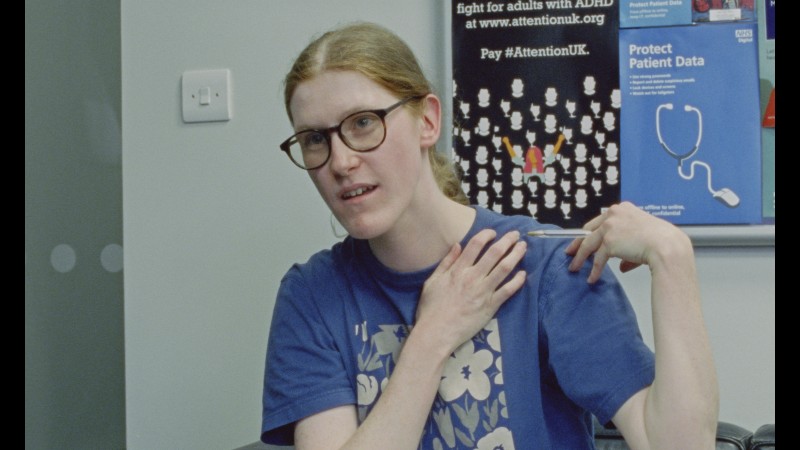LUMI Reviews The Stimming Pool- Camera of the Brain
22 March 2025
LUMI programmer Steven Burrows takes a closer look at The Stimming Pool ahead of its upcoming release at QFT.

The Stimming Pool cements its own space in its formal execution, taking advantage of cinema’s plasticity through its ever-shifting form and by occupying this quite abstract second-person-POV, an experimental corner. The camera becomes a ‘camera of the brain’; mirroring and accessing behaviour, enabling the spectator to witness certain elements of autistic life that will either be familiar but under-represented in our cinema landscape, or entirely unknown. It would be simple enough to commit to a standard documentarian format, find the appropriate subjects and relay the necessary information about their individual ways of life to paint a clear, unambiguous picture for the audience. However, simplicity is not at the heart of what this collective aspires to, nor is their work here for neurotypical audiences to walk away with greater ‘knowledge’. This film is for the collective, and aspires to provide authentic representation of how autistic people engage with the world beyond purely narrative conventions. In abandoning these filmmaking conventions for a more challenging though ambitious execution, it provides a range of tools to gain an understanding of autistic life that can be, depending on the viewer, more rewarding than what would’ve been achieved through a standard documentary format.
This returns me to what I referred to as its second-person POV, the sensation in the film that an undefined figure is, through the camera, accompanying whoever we are seeing at any given moment. In what is a deliberately abrasive and fragmented work, this perspective provides balance, and allows the heart of the film to beat. Not only are its various subjects afforded an intimacy with the camera’s vulnerable calm (whether moving or still), it also avoids othering its subjects because the camera taps into their individual perspectives. Choices such as eye-tracking test footage becoming the film, or the camera beginning to spin when its subject begins spinning, or the constant overlap of cinema verité-style filmmaking, animation, reality and fantasy not only coalesce into an evocative formal experiment, but it gives life to the camera. You become a part of the feature, that “second-person”. An intimate partner to the people we are alongside. The onus thus lies on the viewer. Should you embrace it and fall into its at-first complex approach, then there is much to discover. By engaging with these individual experiences in an abstract, removed manner, the film becomes a mosaic in its own right, and makes visible and discernable that which is often invisible and unacknowledged.
The Stimming Pool maintains its ambition in its sprawling yet occasionally undercooked narrative. There is such a range of individual and collective experiences that it seeks to explore, and while that is admirable, it would have benefitted from a greater runtime. When the formal experiments aren’t as effective, there comes a desire for more time with the people we’re observing. It finds quite cosmic spaces, such as with Chess in the forest, but we’re quickly removed from these in an effort to push towards the ‘creative’ side of the film, and the abstract idea of the titular Stimming Pool. Perhaps this is in service of relaying the struggles that many autistic and neurodiverse people have in neurotypical spaces, the final scene in that Stimming Pool also bitterly brief and fantastical (and evocatively so). The film does mostly sidestep this sentiment and doesn’t feel rushed, in part due to the fact that these aren’t characters and this isn’t a story, and considering how the camera substitutes the spectator in and does its own emotional relaying. However, even during its more realist, more formally conventional periods (the reception, workplace and pub scenes come to mind), I still sought to feel those moments more. Ultimately, there is an imbalance there. With some of the people there comes a strong sense of their inner lives; their conflicts, passions, desires, connections. Though, with others, their inclusion appeared to mostly serve the form and their contributions to the film primarily centring on how their autism related to the overall piece, which is important but does come with its own questions and issues. These contrasts come with taking risks and experimenting, and fortunately the structure of the piece allows for such a natural flow and stylistic freedom wherein the flaws are natural too, the film allows its people and itself to be. However, greater time in these environments and with these people would have afforded the film an even stronger sense of wholeness.
The Stimming Pool finds beauty in its unique relationship between camera and individual, a sensual portrait of each person and this entire group simultaneously. It’s also quite a dense and inspiring portrait of individuality, creativity, artistic process and finding your place as an artist. In fact, it finds its own place throughout the course of the film through its various filmic choices. Where it begins considering ideas, testing itself, questioning its people, it settles with them all in one place, individuals but a collective too in that Stimming Pool. It’s a testament to uncensored, unrestrained art and expression, that they are able to discover that space upon the film’s conclusion. During this final sequence, the camera continues to swing and flow - it wasn’t just a filmic choice, it lives.
The Stimming Pool is showing on Saturday 29 and Monday 31 March at QFT.




